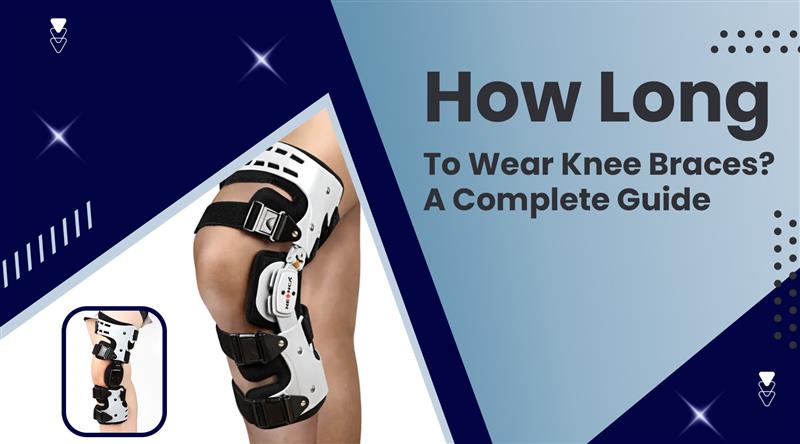Knee brace plays a crucial role in protecting, stabilizing, and easing the pain in the knee. They act as essential tools for anyone who is recovering from serious injury, or surgery, or coping with chronic conditions like arthritis. They protect delicate knee structures and aid in healing by lessening the strain on damaged ligaments, cartilage, or joints. It stabilizes the joint and ensures safe and regulated mobility while lowering the chances of mobility and discomfort. Knowing How Long to Wear Knee Braces can significantly influence the success of the recovery.
Knee braces are designed to provide a particular kind of protection or alignment for the knee. For example, those who are suffering from meniscus tears, patellar tracking issues, or tears in the ACL (anterior cruciate ligament) can use a knee brace that manages their specific injury or dysfunction.
Types of Knee Braces and Their Specific Uses
Knee braces do come in various form factors, each being tailored to provide a specific support level based on the injury type or personal need. Here are the different types of knee braces:

-
Knee Sleeves:
Knee sleeves are the most basic form of knee support one can get. They do provide mild compression and are very ideal for everyday use or low-impact activities. While they do not offer very rigid support to your knee, their snug fit around the knee improves your blood circulation. It leads to reduced swelling and offers a fine stabilizing effect for individuals who are dealing with minor pain or inflammation.
Knee sleeves are especially beneficial for those with mild arthritis or low-level swelling. They manage joint stiffness and provide light support without limiting mobility. Professional athletes often can be seen wearing best knee support brace for running as they provide additional warmth and comfort during training sessions, especially in sports with moderate intensity, such as jogging, weightlifting, and cycling.
-
Hinged Braces:
Hinged braces are specifically engineered for those who need a higher level of support, which is particularly beneficial after surgeries or severe knee injuries that involve ligaments (ACL, OCL, or MCL). Spring loaded knee braces and hinged braces with knee brace undersleeve options are available to add comfort and support, especially for those who are recovering from ligament injuries.
Hinged braces have metal or plastic mountings (hinges) on either side of the knee that manage and limit sideways motion, protecting the knee from getting injured again. Hinged braces are generally prescribed for individuals who are recovering from ligament tears or reconstruction surgeries. These braces allow controlled bending and straightening of the knee, which can aid in rebuilding strength and maintaining stability as the knee recovers.
-
Patellar Tracking Brace:
This brace is specially crafted to stabilize the kneecap (patella), which can shift out of place due to weakness, instability, or misalignment. To ease the pain and stop further dislocations, patellar tracking braces come with additional straps or padding that help the kneecap to move into its natural position. Patellar tracking braces are frequently advised for those individuals who suffer from chondromalacia, patellar instability, or recurring dislocations. For women or athletes, knee brace for women and child’s knee brace are also available with the tailored support system for specific tasks.
-
Unloader Braces
People with arthritis frequently use unloader braces. Their intended use is to unload the pressure off the injured side of the knee by moving the weight-bearing load from that affected area to an unaffected one. By easing the strain on the arthritic region, unloader braces generally help people with osteoarthritis manage their pain and make their regular actions like walking easier. These braces are very prominent among athletes who face persistent joint problems.
How Long to Wear Different Types of Knee Braces Post-Injury or Surgery

Post-injury or Post-Surgery Braces
- ACL or Ligament Injuries:
Mild Injuries: After an incomplete tear of the ACL or other ligaments, a hinged knee brace might be worn, if not for 4-8 weeks. The brace will also offer stabilization However, it is important to remember that, during this stage of recovery and for the prevention of re-injury, restricting side-to-side movement. Others (those with more significant instability or requiring maximum protection). A knee brace after surgery can act as a savior in these situations.
Post-Surgery: A hinged knee brace is usually worn at all times for the initial 10 weeks postoperatively to protect the healing ligament against sudden twists and lateral forces. The brace may be kept straight initially and adjusted to allow only gentle bending as recovery advances. The brace may be recommended by physical therapists for the first few weeks, even to sleep with, and then transition gradually over.
- Meniscus Tears:
Non-surgical treatment of the meniscus tear requires typically 6 weeks with a brace. This will provide stability, which minimizes the strain, permitting the meniscus to heal by itself and reducing pressure on the knee. Patients typically wear it for all weight-bearing activities to avoid further tearing or discomfort.
- Patellar Dislocation:
A patellar tracking brace is often prescribed after a patella dislocation to hold the kneecap in place so that it can heal properly. The brace can be worn by the patient for 2-3 months so that it prevents the kneecap from dislocating again and distracts his/her kneecap. The duration of use is individual and depends on some factors like history of recurrence in the specific joint, overall stability at surrounding joints where kinematic deficiencies should be corrected, or just during activity. Most initial usage is in the form of full-time bracing, and wear decreases as alignment improves.
Conclusion
Knee braces play an important role in expedited recovery and injury prevention, which allows individuals to keep up with their active lifestyles despite having certain knee conditions. Choosing the best knee brace for stability and adhering to the recommended use schedule helps ensure recovery. Spring loaded knee brace options may provide additional support for those prone to hyperextending knee brace needs. Consulting medical professionals ensures brace choices and wear times meet specific recovery goals, especially for those using a waterproof knee brace for hyperextension and knee brace for women options based on unique anatomy.
Tick Trend’s knee brace will free you from pain, and kick-start your recovery, powering every chapter of your comeback story. These braces will not only help you with day-to-day tasks without stress but also will allow you to recover from your injuries quickly.
FAQs
For a mild knee sprain, you should consider wearing a knee brace for support during weight-bearing tasks for at least 2-4 weeks.
For a mild MCL injury, consider wearing a hinged knee brace for around 4-6 weeks. For more severe injuries, continuous bracing might be needed for up to 8 weeks to allow healing.
You can hand wash the braces with the use of mild detergent in cold water, then air dry.
Yes, you can wear a knee brace over that for comfort, but the best fit is directly on the skin. You can wear it over very thin-fitting pants or leggings.
Make sure the knee brace does not slip at all by keeping it adjusted to fit properly. Try an extra non-slip sleeve under the brace or putting the straps under the area of application tightened inappropriately, but please avoid wearing lotions and oils on these areas before attaching the braces.


